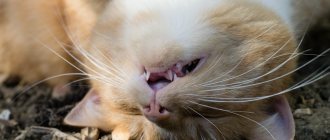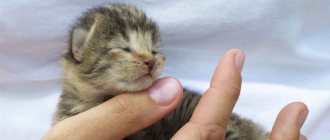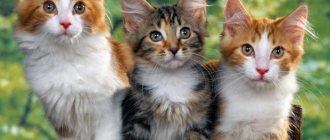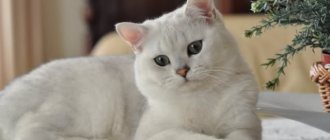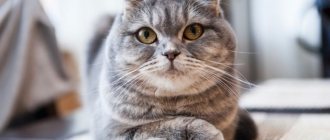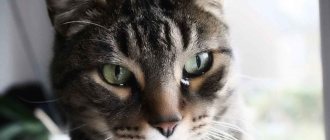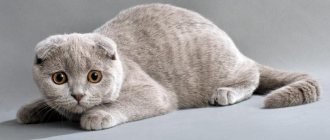Snoring is almost as common among cats as it is among people. Therefore, the characteristic sounds made by a pet during sleep are not always an alarming sign of serious pathologies. There are breeds that are predisposed to snoring due to the specific structure of the muzzle and olfactory organs in particular. There are cats that snore on their own, even though it doesn't happen that often. It is difficult to count all the reasons why a cat snores. In this article we will try to cover all aspects of cat snoring, its painful and healthy sides.
The cat snores
Types of snoring
Hardly any owner is aware that there are different types of snoring. Meanwhile, it is the nature of the sounds made by the pet that helps the veterinarian establish an accurate diagnosis. Before visiting a specialist, it is advisable to listen to the cat’s night breathing and describe its changes in detail, since the veterinarian will not be able to observe a sleeping cat live.
Determining the type of snoring is an important step towards diagnosing a possible disease.
To make it easier to recognize a specific type of snoring, we provide their descriptions below.
Table 1. Types of cat snoring
| Type | Description |
| Dry snoring | This type of snoring is recognized only when exhaling and sounds similar to hissing. Grunting breaths can only be heard when using special equipment in a veterinary clinic. Dry snoring usually marks narrowing of the trachea and bronchi and other problems with the respiratory system |
| Wet or bubbly snoring | Snoring owes its second name to the expressive sound that accompanies snoring, reminiscent of bursting bubbles. It appears as if something like bubble wrap is stuck in your pet's airway. Wet snoring is clearly audible when inhaling and exhaling |
| Inspiratory snoring | This type of snoring sounds more like whistling or hissing or even noises. Changes in breathing are clearly audible both during inhalation and exhalation. The main cause of inspiratory snoring is narrowing of the upper airways |
| Rattling or crepitating snoring | The easiest reason to diagnose is crackling snoring, which occurs due to the straightening of the stuck together alveoli during inhalation. Alveoli are bubble formations in the lungs that normally do not manifest themselves in any way. A crackling sound when snoring indicates a change in their condition. If such snoring is recognized, consultation with a doctor is mandatory. |
Why is the cat snoring?
The respiratory system of cats is similar to humans. Our pets can sigh, sniffle and even snore in the same way. Most often this happens in a dream. Dreams of cats can consist of various events that cause an external reaction not only in the form of twitching their paws, as if the animal is running, shuddering, but also reactions of the respiratory system.
But if a cat or kitten sniffles not only during sleep, but also when awake, this may indicate the appearance of health problems. In this case, the owners need to more carefully observe the pet, which sniffles when it breathes, and track the duration and frequency of the snoring. This can help in determining the cause of the condition, and in deciding what to do and how to treat the animal.
The most common causes of cat snoring
:
Periodic snoring is normal for humans and animals. If this happens rarely, it should not be a cause for concern. But if it's a cat sniffling while breathing all the time, or even breathing with its mouth open, it should be a cause for concern. Persistent breathing problems can lead to more serious health problems. Most likely, you will need a veterinarian's consultation and treatment, because... It is difficult or even impossible to independently determine the disease. But before contacting a doctor, it is necessary to observe an animal that is sniffling and breathing heavily. To make a diagnosis, exclude various diseases and prescribe the correct treatment, the doctor will need detailed information.
The veterinarian may ask for the following information about a cat who wheezes when he breathes:
:
- the age of the animal and its lifestyle;
- weight and its relationship with the norm for a given breed;
- how long ago did the wheezing occur?
- Are there other sounds heard when the cat breathes?
- changes in the color of mucous membranes;
- the presence of various injuries (torso, nose, mouth, larynx);
- changes in behavior (low activity, weakness, excitability);
- other symptoms (digestive problems, vomiting, other breathing problems, cough, runny nose, sneezing).
If your cat is breathing poorly through his nose and sniffling, you should not wait for this to go away on its own. Such signs may indicate a serious illness in a cat or kitten that requires immediate treatment.
The nature of the snoring and sounds can often roughly determine the source of the disease.
:
- wet rales indicate the presence of phlegm in the respiratory organs;
- dry wheezing indicates the presence of swelling in the bronchi or throat;
- crackling – there may be problems in the alveoli;
- A whistling sound may indicate swelling in the respiratory tract.
Only timely initiation of treatment and the correct choice of medications can ensure a quick and complete recovery of the pet. You should not rely on the recommendations of other cat owners from forums - each case is individual, even with similar symptoms.
Cat lovers take care of their pets like children. The slightest deviation in animal behavior or oddities causes anxiety for cat lovers. One of them is cat snoring. Cats snore for various reasons. Let's look at them in more detail.
Snoring among people and even among dogs is a normal, common occurrence. Cats snore much less often in their sleep, but it does happen. This most often occurs with breeds with a flattened muzzle.
Such animals have short sinuses in the nose, which leads to a “source of noise” during sleep.
This phenomenon is commonly called brachycephalic syndrome.
Snoring breeds include:
- Persians;
- Briton and Scottish cats;
- Exotic cats and others.
Just because your pet has a flattened face does not mean that he cannot get sick. Observe the animal and if you think the temple is abnormal, consult your veterinarian immediately.
Brachycephalic syndrome can manifest itself in three types. Owners of brachycephalic breeds should be well versed in their characteristics.
One of the most common symptoms is a stenotic nose.
It is represented by small nostrils through which air flows at a lower speed. Such cats should not lead an overly active lifestyle and should not be exposed to stress that can cause shortness of breath or heart failure.
Another irregular structure of the muzzle is an elongated soft palate.
. The cat's palate sags down and prevents air from passing through.
Cases of tracheal stenosis are not uncommon.
This means that the tracheas of breeds at risk are narrowed in places. This structure makes them vulnerable and is a pathology.
Cats of other breeds may also snore and wheeze in their sleep. If this process is accompanied by grunting, tail wagging and limb twitching, this is normal.
Comprehensive diagnostics
Cat owners should remember that any pathology has several manifestations at once, which make it possible to more accurately determine the disease. If you don't notice any changes in your pet other than snoring, there is most likely no cause for concern. Of course, an extra trip to the vet is never harmful.
If you have any doubts about your cat's health, take it to the veterinarian, describing in detail your pet's snoring.
However, cats whose snoring is accompanied by other negative symptoms that are not immediately noticeable and sometimes almost completely unnoticeable deserve special attention. Less obvious manifestations of a possible disease include:
- General weakness, apathy;
- Lack of appetite;
- Temperature increase;
- Digestive disorders: diarrhea, diarrhea, constipation;
- Shortness of breath during free time from sleep, difficulty breathing;
- Frequent sneezing;
- Cough.
When diagnosing the disease, you should pay attention to the painful manifestations that accompany snoring.
Taking an anamnesis
If you have checked one or more items from the above list, you should collect a preliminary medical history to prepare for the veterinarian’s upcoming questions. The anamnesis includes the following information:
- Age and basic habits;
- Accurate weight;
- The time of occurrence of snoring and the possible reasons with which the owner associates it;
- The specificity of the extraneous sounds causing concern - whether they are heard during inhalation, exhalation, or both;
- Paleness or, conversely, inflammation of the mucous membranes during sleep or immediately after waking up;
- The presence of traumatic brain injuries or injuries that affected the muzzle or some parts of it;
- The manifestation of indirect symptoms indicating the painful condition of the pet, indicated above.
A comprehensive history will help the veterinarian quickly understand the pet’s condition.
Pet care
Drug therapy is an important consideration when treating your pet for snoring. But a caring owner also needs to provide competent care for the pet during illness.
- First of all, you need to create comfortable conditions for him. Arrange a soft bed and place it in a secluded place where the pet could restore its strength without being distracted by extraneous factors.
- If an animal refuses to eat, then you should not force it to eat. As soon as his health improves, he will go to the bowl himself.
- If a cat's snoring is accompanied by a cough, it is recommended to give the pet as much water as possible so that phlegm comes out of the lungs more easily and quickly. You can use a special sippy cup for this purpose.
- You should monitor the cat’s well-being during treatment, and if no positive results are found, you will need to contact your veterinarian again to select the most effective treatment.
With suitable therapeutic therapy and proper care, the cat will very soon cheer up and again delight its owner in a good mood.
Diseases associated with snoring
Despite the fact that the range of pathologies that lead to snoring is wide - from thickening of the soft palate to polyps in the lungs, there is a list of the most relevant diseases that owners of snoring pets face.
Laryngeal edema
Edema is difficult to attribute to pathologies; rather, it is a consequence of an allergic reaction that was not recognized in time by the owner. An allergen can be a product or some object that once entered the pet’s larynx and caused inflammation. To protect the sleep of an allergic cat, it is advisable to remove the allergen from the house that has a constant impact.
Laryngeal swelling may be accompanied by other typical allergic reactions
If the swelling was caused by autoimmune diseases, the veterinarian selects stabilizing therapy that strengthens the pet’s body’s resistance.
Asthma
It is difficult to talk about the causes of asthma because they remain largely unclear. Genetic and breed factors influence. For example, bronchocephalic breeds already familiar there are more predisposed to this disease. In addition to snoring, asthma is accompanied by suffocating coughing attacks, which are sometimes mistaken by owners for a manifestation of the gag reflex; later shortness of breath, apathy, and lack of appetite join the cough.
Spicer with mask for lung inhalation
Asthma comes in several forms:
- Moderate - this type of asthma usually goes unnoticed by the owners. The cat sometimes coughs and wheezes, but shows no other signs of illness and appears healthy;
- Moderate-severe – coughing attacks torment the pet several times a day, sometimes leading to suffocation;
- Acute-severe - this form is accompanied by respiratory failure and narrowing of the animal’s bronchi, threatening its life. In case of acute-severe asthma, the animal is hospitalized as soon as possible.
Owners of animals prone to asthma and chronic bronchitis will sooner or later need to inhale their animals at home. You can read about the inhalation itself and how it is carried out below.
We give the cat an inhalation
Urolithiasis disease
Despite the fact that urolithiasis does not affect the lungs and extends its influence to the kidneys and genitourinary system, wheezing often accompanies advanced stages of the disease. With intoxication and periodic pain, the occurrence of extraneous sounds during breathing is not uncommon. Diagnosing urolithiasis as the primary source of wheezing is not difficult - unsuccessful trips to the toilet and blood in the urine are an unambiguous signal to begin serious treatment.
Symptoms of urolithiasis in cats
KSD is more common among males due to the structural features of their genitourinary system. Moreover, young individuals are susceptible to the disease, while in animals after six years of age this pathology is diagnosed relatively rarely. At risk are castrated cats that have had their gonads removed.
Parasitic diseases
The assumption that worms are located only in the gastrointestinal tract is deeply erroneous. With untreated infestations, parasites also enter other organs through the circulatory system, and the lungs are no exception. In addition to the possible entry of larvae into the respiratory system, infection with parasites generally inhibits the functioning of the body, negatively affecting metabolic processes.
Types of parasites
In severe cases, an animal infected with roundworms begins to experience heart failure, accompanied by difficulty breathing during sleep. You can recognize a parasitic infestation by the changed appearance of the animal - infected cats, as a rule, rapidly lose weight. In addition to weight loss, parasitic infestations are accompanied by:
- Enlarged abdomen, pain when trying to palpate;
- Loss of clumps of hair, regardless of shedding;
- Yellowing of the mucous membranes due to liver enlargement;
- Repeated attempts by the cat to lick the anus due to increasing itching.
Analysis of an animal's feces will provide reliable information about the presence of parasites in its body.
Bronchitis
It is quite difficult to notice snoring while missing other symptoms of bronchitis, so, as a rule, owners have no doubts about the pathology of the respiratory system when they come to the veterinarian. The only difficulty is that in cats, coughing, sneezing and vomiting are very similar to each other and it can be difficult for a person uninitiated in feline diseases to distinguish all these painful manifestations.
With bronchitis, a large amount of pus is released from the animal's nose
One of the sure signs of a lack of oxygen that occurs during bronchitis is the blueness of the mucous membranes, which is also characteristic of asthma. To check the shade of the mucous membranes, just lift the animal’s upper lip and look at the gums.
With bronchitis, a dry cough is most often observed, sometimes accompanied by sputum production. Bronchitis can also be accompanied by non-specific symptoms such as diarrhea or vomiting (due to severe coughing).
Heart failure
A number of factors lead to heart failure, including:
- Congenital heart defect;
- Parasitic infestations;
- Untreated infectious diseases;
- Hyperthyroidism;
- Prolonged emotional experiences;
- Belonging to certain breeds: Sphynxes, Maine Coons, Persian, British and Norwegian forest cats are at risk.
Overweight cats are more likely to develop heart failure
Symptoms of heart failure can in some cases be confused with pneumonia, bronchitis or asthma. This disease is also characterized by shortness of breath, blue discoloration of the mucous membranes due to oxygen starvation of organs and tissues, and moist rales. In severe cases, heart failure leads to fainting and even paralysis of the hind limbs (due to a blood clot).
Obesity
Excess weight can form both as a result of an unbalanced diet and as a result of hormonal disorders in the pet’s body. Some breeds (for example, the British cat) are predisposed to rapid weight gain, so the diet of such animals requires a particularly careful approach. Due to lack of physical activity, all pets are equally at risk, especially those that have been sterilized.
Excess weight interferes with your pet's normal breathing and overloads his joints.
The consequences of obesity can be global - from joint problems to heart failure. The appearance of snoring just indicates an increase in the load on the cardiovascular system, which cannot cope with the animal’s body weight.
Why does the cat snore?
Many owners, hearing snoring coming from their pet, begin to sound the alarm and take the cat for all kinds of examinations. In some cases, such care actually turns out to be useful and helps to recognize the disease in the early stages. But is snoring alone worth the complete mobilization of cat owners? Let's consider the circumstances in which snoring fits within the norm:
- Let's start with the fact that in a completely relaxed state, a cat can make a whole range of sounds: from purring and squeaking to snoring and snoring.
The muscles of the chest come to a resting state, which only contributes to the production of various guttural sounds; Making extraneous sounds during sleep is natural for both humans and cats - Scientists have proven that animals see colorful, meaningful dreams and deeply experience the events that occur in them.
For example, dogs or cats can imitate running in their sleep, which will cause them to have shortness of breath and shortness of breath. During dreams, pets can meow, bark and even growl, not to mention snoring. However, such active actions during sleep are a rare phenomenon that will not occur every night; Cats can react violently to events occurring in dreams - Brachycephalic cats are more prone to snoring than their relatives.
A flattened nose suggests its own nuances of functioning. By the way, brachycephaly is common not only among cats, but also among dogs. An excellent example of this is the pug and those recognizable sounds that it makes even while awake. Brachycephalic cats include Persian cats, Scottish Folds and Straights, British and Himalayan cats. It is these breeds that are predisposed to asphyxia, shortness of breath and heart failure; Brachycephals are distinguished by a flattened muzzle, which prevents easy breathing - The more weight a cat has, the more prone he is to snoring.
Excess weight is one of the main causes of snoring in both humans and animals. Therefore, if you correlate the appearance of nightly “concerts” with your cat’s weight gain, then think about changing his diet and increasing active exercise. Obesity contributes to snoring and increased stress on the heart
Another cause of snoring, which is not related to pathologies, but is not a variation of the norm, is a foreign body getting stuck in the animal’s nasal sinuses. This reason may be relevant for families with children who play with construction sets and other toys with small parts.
The main danger of a stuck object is an unexpected attack of suffocation, which can occur unexpectedly for the animal's owners. Prolonged presence of a foreign object in a cat’s nose is also fraught with the appearance of inflammatory and purulent processes.
Brachycephalic syndrome
Let us dwell in more detail on brachycephalic syndrome, which is a key feature of some breeds. The structure of the muzzle of brachycephalic breeds has the following features:
- Stenotic nose - this type of nose is characterized by small nostrils through which air flows more slowly.
This shape of the nose does not imply too much physical activity, which will lead to prolonged shortness of breath and increased stress on the heart; Due to the specific structure of the nasal sinuses, the nose of brachycephalics requires more attention from a veterinarian - Elongated soft palate – the soft palate of short-snouted animals sags downwards, creating an additional obstacle to the free circulation of air.
As a result, the pet makes recognizable grunting and snorting sounds, which intensify with movement; With a normal structure, the soft palate does not interfere with the breathing of animals - Tracheal stenosis – the trachea of brachycetal breeds narrows in some places, which is considered for normal pathological tracheas. This structure of the trachea makes it vulnerable.
The cat snores
caringforpets.net, 2018
Is it normal for a cat to snore in its sleep? Perhaps this is caused by some health problems? Such questions often bother owners.
Snoring in cats
does not occur very often, much less frequently than in dogs. A sleeping cat usually does not make any sounds; she even breathes very quietly. Therefore, owners often become concerned if they notice that their furry friend has begun to snore. Although snoring is not usually a sign of illness, in some cases it should be cause for concern.
If you hear snoring during sleep, this is a sign that something is blocking the movement of air in the upper respiratory tract. This happens from time to time in all animals and in humans. With normal snoring, the sounds are quiet and low. Their cause is the appearance of fluid in the respiratory canals.
It has been noted that representatives of some breeds snore more often. Breeds with flat faces are predisposed to snoring. If you have a Himalayan or Persian cat, don't be surprised if she snores occasionally.
This is due to the fact that the flattened shape of the facial part of the skull causes some breathing difficulties. Flat-faced breeds are thought to have narrower nasal passages. In addition, their palate protrudes outward, thereby making it difficult for air to pass through.
Snoring in cats occurs for many reasons. Quiet snoring usually does not indicate any problems. Loud - may be a sign of illness.
Cat breed
Some breeds are characterized by a round head shape with a flattened face. This is brachycephaly. In animals of such breeds, the ratio of the length and width of the skull is greater than normal, the jaws are shorter, and the nose is flattened.
Accordingly, the nasal passages are shorter. Brachycephalic cats also have an elongated soft palate. It obstructs the passage of air when breathing, especially in a relaxed state.
All this contributes to the occurrence of snoring.
A striking example of a brachycephalic breed is the extreme type Persian.
Sleep position
Cats sleep a lot and enjoy it. They can sleep in the most bizarre positions. Sometimes this leads to the fact that the free access of breathing air is disrupted, as a result the animal begins to snore. When you change your body position, snoring stops.
Overweight, obesity
Excess weight contributes to snoring. When you gain weight, fat is deposited both externally and in the internal organs. It can also build up inside the throat, narrowing the passage for air. This mainly occurs at night, especially when the cat is sleeping.
In addition, with obesity, muscles become weaker. The throat muscles also weaken and become less elastic. As in aging animals, laxity of the throat muscles contributes to snoring.
Snoring can be a symptom of serious illnesses.
Cats are susceptible to viral and bacterial upper respiratory tract infections. They can be called:
Along with snoring, infectious diseases are accompanied by symptoms such as coughing, wheezing, snoring, sneezing, lethargy, eye discharge and fever. If any of these symptoms appear, you should immediately contact your veterinarian.
Nasal obstruction
The reason why cats snore may be a narrowing of the nasal cavity, making it difficult to breathe normally. This is caused, for example, by the formation of tumors or polyps in the nasal cavity. Also often the cause is a foreign object stuck in the nose.
When does snoring become a cause for concern?
If there are no other symptoms other than snoring, and if the cat has no infections, tumors or polyps, there is nothing to worry about. However, you should consult a doctor if you notice any of the following symptoms:
- Hard breath;
- Open mouth when breathing;
- Wheezing;
- Cough;
- Nasal discharge;
If these symptoms occur, cat snoring is not normal.
Is it possible to cure a cat for snoring?
If the cause is a disease, snoring will stop after it is treated. If it is associated with the shape of the front part of the head, it cannot be eliminated.
In the case of an elongated palate, surgery to change its shape is possible. However, this is rarely done as such operations are very expensive.
Tumors and polyps are also removed (or reduced in size) surgically.
Most cases of feline upper respiratory tract infections are associated with a cold. To alleviate the condition, nasal drops are prescribed to clear the passage of air. Antibiotics are used if necessary. Veterinarians also recommend using a humidifier in the home.
When is urgent veterinary intervention necessary?
Signs that indicate you need to see a doctor immediately
:
- The animal suffocates while sleeping.
- Dry and hot nose, apathy, the cat does not eat well, is apathetic, diarrhea, vomiting.
- The cat sneezes and coughs all the time.
- There is mucus or fluid coming out of your cat's nose.
- The voice became hoarse, low or, on the contrary, too high.
- Swelling appeared on the face, especially near the nose.
- The cat tries to breathe through its mouth, stretches its neck as if something is bothering it.
Why does a cat snore in its sleep and what does it mean?
When a cat snores loudly, many stress-resistant owners do not pay attention to it; people with light sleepers simply send their pet to sleep in another room. But, as a rule, no one thinks about the fact that an animal’s “loud” sleep may indicate illness.
About cat snoring
You should treat snoring normally if you have a representative of any brachycephalic breed - such animals have a short and often flattened nose. For example, many Persians sleep quite loudly from childhood.
Cats, like people, also sometimes dream. They are usually very rich and bright. In his dreams the pet:
- chases prey;
- flees from pursuers;
- gets into fights, etc.
At such moments the beast strongly:
- sniffles;
- grunts;
- snores.
This is usually accompanied by clenching the fingers, extending the claws, wagging the tail, etc. It is not difficult to stop this - just change the cat’s position. As a rule, such situations do not occur too often and do not pose a health hazard. The only thing that can make you worry is frequent dreams. They often indicate that your pet is stressed.
However, you need to be wary when your pet, in the previous years of its life, rested quietly, then suddenly begins to make characteristic sounds during sleep.
Signs of the painful nature of snoring
The following factors increase the risk of developing pathologies that cause snoring:
- age – over 5 years;
- metabolic problems (mainly obesity);
- low physical activity.
It is important to pay attention to some points - the veterinarian will ask about them:
- How long has it been since your cat started snoring?
- When is it heard (during exhalation or inhalation)?
- Have your mucous membranes turned pale?
- Has the cat been injured?
Symptoms indicating the development of a disease are as follows:
- weakness;
- vomit;
- diarrhea;
- cough;
- apathy;
- nervousness;
- labored breathing.
For example, wet wheezing when inhaling indicates problems with the lungs. Dry, on the other hand, signals swelling of the upper tract.
What diseases cause cats to snore?
As previously noted, in some cases, snoring is not a sign of a serious health problem. But only a visit to the clinic will make sure that your worries are in vain.
During the examination, hyperplasia is often detected in animals. This is what doctors call a thickened soft palate. If this does not cause any significant inconvenience to the cat, treatment is not particularly necessary. Otherwise, the problem is corrected surgically.
At the same time, snoring is often caused by the following diseases:
- asthma;
- swelling of the larynx;
- helminth infection;
- urolithiasis disease;
- bronchitis;
- pneumonia;
- heart failure;
- and finally obesity.
For example, swelling is in most cases a sign of allergies. Identifying the irritant and taking antihistamines will help eliminate snoring.
Asthma is always accompanied by very characteristic attacks of suffocation. They are observed both during sleep and during wakefulness.
With urolithiasis, wheezing is caused by pain and intoxication. The thing is that accumulating sand sometimes closes the urinary canal. Stagnation of urine leads to frequent inflammations, which cause more suffering.
Worms can settle in any organ, and the respiratory system is no exception. Even if this does not happen, severe infection often leads to metabolic disorders, and this, in turn, contributes to the development of heart failure and breathing problems.
Both pneumonia and bronchitis have quite obvious accompanying symptoms:
- temperature;
- snot;
- cough;
- wheezing, whistling when breathing.
The British cat has a hereditary tendency to such diseases.
If a cat has developed heart failure, he will wheeze both when inhaling and exhaling. The diagnosis is made on the basis of an ECG.
In all cases, self-medication is extremely dangerous, because without knowing the exact diagnosis, you can only worsen the pet’s situation.
https://youtube.com/watch?v=pMQMuJcpZ2Y
Treatment
At a veterinary clinic, the doctor performs a full examination of the animal, in particular the nasopharynx and throat, and may prescribe an x-ray or blood test. Of course, in order for the animal to allow such manipulations, it is given anesthesia.
After all the steps, the veterinarian will be able to determine the cause of snoring and prescribe appropriate treatment. Depending on the type of problem, treatment may vary. These can be special ear swabs that need to be used when the animal falls asleep, or medications, diet, sometimes surgery, and so on.
Snoring is directly related to the respiratory system. Many breeders are afraid to perform surgery on their animals, others simply put it off until later due to lack of time. But in some cases, snoring can lead to the death of an animal. Foreign objects, fractures, inflammations can simply block his access to oxygen. So treatment must be immediate and of high quality.
Some strange sounds wake you up at night. It turns out that your cat is snoring. I feel sorry for the little animal and myself. What to do in such cases?
Why does a cat snore through its nose and sniffles like a human when it sleeps, but there is no snot?
There are breeds of cats and dogs that are prone to snoring. These are animals with a shortened nose, for example, Persians or exotics. They snore or sniff slightly during sleep - this is a natural phenomenon. Sniffling can also be a sign of illness.
What to do if a cat becomes electrified and why does this happen?
A cat's fur can become electrified by dry indoor air. In winter, it is necessary to humidify the air in the apartment so that it is about 50–60%. Static electricity in wool can occur when it comes into contact with the owner's synthetic clothing or furniture upholstery. You can spray your clothes (but not your cat) with antistatic agent.
Why does a cat constantly snore and is it dangerous, how can I help?
Diseases that may cause a cat to snore: - helminthic infestations; - asthma; - polyps in the nose; - excess weight; - hyperplasia of the soft palate; - heart failure; - urolithiasis disease; - brain injuries.
It is necessary to observe the animal in order to know what to tell the veterinarian. How does a cat snore - through its nose or mouth, while inhaling or exhaling, what kind of appetite and behavior. A veterinarian will examine the animal and be able to prescribe treatment. An x-ray of the nose may be needed if snoring is caused by polyps or a deviated septum.
The cat snores when inhaling and when breathing, what to do and how to treat it, is it normal or bad?
Snoring or wheezing while inhaling may indicate bronchospasm. This condition occurs during an asthma attack. If the cat previously suffered from allergies that were not treated, asthma is a logical continuation of the disease in a more severe form. This disease is life-threatening; the animal can simply suffocate while sleeping. It is necessary for the doctor to prescribe a treatment for the cat that will definitely help.
A cat snores after anesthesia, what to do?
After anesthesia, the animal may feel unwell - refuse to eat, snore through its nose. Usually the condition returns to normal within a day. There is no need to disturb the cat, forcefully pour water into it, it may vomit. If the snoring does not go away within the next few days, take your cat to the vet.
Cat snores after sterilization
Snoring can be caused by various reasons, one of which is heart failure. Therefore, the operation is recommended for animals at a young age. There is a danger of urolithiasis due to changes in metabolism in the body. One of the symptoms of this disease is snoring.
After sterilization, the animal is transferred to specialized industrial feed intended for sterilized animals.
This serves to prevent the occurrence of kidney disease. It is necessary to monitor the weight of the animal; after sterilization, a tendency towards obesity appears - this is also one of the reasons for snoring in a cat.
When a cat snores loudly, many stress-resistant owners do not pay attention to it; people with light sleepers simply send their pet to sleep in another room. But, as a rule, no one thinks about the fact that an animal’s “loud” sleep may indicate illness.
